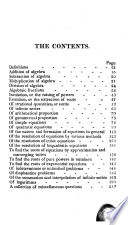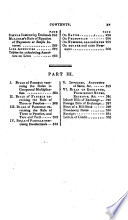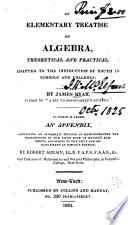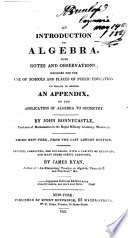 | John Bonnycastle - 1811 - 230 σελίδες
...III. The last term of any arithmetical series is equal to the sum or difference of the first term, and the product of the common difference by the number of terms less , one ; according as the series is increasing or decreasing. Thus, the 20th term of 2, 4, 6, 8, 10, 12, &c.... | |
 | John Bonnycastle - 1813 - 456 σελίδες
...2 x (a+2d). 5. The last term of any increasing arithmetical series is equal to the first term plus the product of the common difference by the number of terms less one ; and if the series be decreasing, it will he equal to the first term minus that product. Thus, the... | |
 | John Bonnycastle - 1818 - 284 σελίδες
...Or, the sum of any increasing arithmetical series may be found, without considering the last term, by adding the product of the common difference by the number of terms less one to twice the first term, and then multiplying the result by half the number of terms. And, if the series... | |
 | John Bonnycastle - 1818 - 326 σελίδες
...(a+4d)=(a+d)+(a+3d)=2 X(o+2«i). 5. The last term of any increasing arithmetical series is equal to the first term plus the product of the common difference by the number of terms less one ; and if the series be decreasing, it will be equal to the first term minus that product. Thus, the... | |
 | Thomas Keith - 1822 - 354 σελίδες
...13- &c- be 'n arithmetical progression, then will 4. The difference between the extremes is equal to the product of the common difference by the number of terms less one> Thus, if 3. 5. 7. 9. &c. be in arithmetical progression, Tlien will 9—3=2x4—15. The number of terms,... | |
 | Enoch Lewis - 1824 - 92 σελίδες
...subsequent term, it is manifest that the whole sum, by which the first term is increased or diminished, is the product of the common difference by the number of terms less one. (48.) The sum of the extremes is evidently equal to the sum of the second from thebeginning, and the... | |
 | James Ryan, Robert Adrain - 1824 - 542 σελίδες
...the terms. Hence the last term of any arithmetical series is equal to the first term plus or minus, the product of the common difference, by the number of terms less one. 469. Also, if s be put equal to the sum of any number of terms of this progression, we shaU have And... | |
 | James Ryan - 1824 - 550 σελίδες
...the terms. Hence the last term of any arithmetical series is equal to the. first term plus or minus, the product of the common difference, by the number of terms less one. 469. Also, if s be put equal to the sum of any number of terms of this progression, we shall have And... | |
 | Warren Colburn - 1825 - 400 σελίδες
...express the whole until a particular value is given to «. Let I be the term required, then Hence,any term may be found by adding the product of the common...What is the 10th term of the series 3, 5, 7, 9, &c. 1 In this a = 3, r = 2, and n — 1=9. Z = 3 + 9 X 2 = 21. In a decreasing series, r is negative. Example.... | |
 | John Bonnycastle - 1825 - 336 σελίδες
...-:d)= x (a+td.) 5. The last term of any increasing arithmetical series is equal to the first term plus the product of the common difference by the number of terms less one ; and it ^ the series be decreasing, it will be equal to the first term minus that product. Thus, the... | |
| |